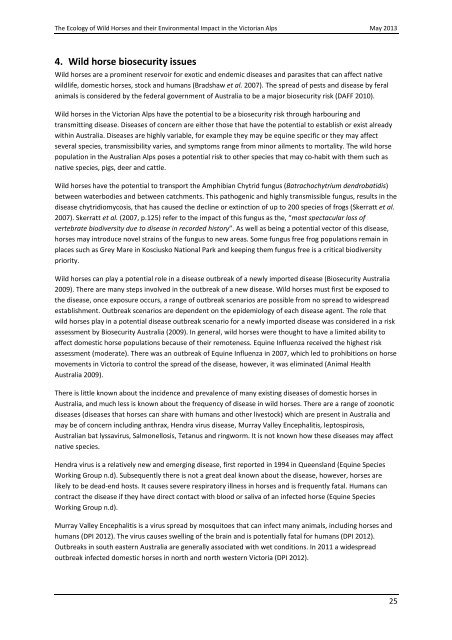The Ecology of Wild Horses and their Environmental ... - Parks Victoria
The Ecology of Wild Horses and their Environmental ... - Parks Victoria
The Ecology of Wild Horses and their Environmental ... - Parks Victoria
Create successful ePaper yourself
Turn your PDF publications into a flip-book with our unique Google optimized e-Paper software.
<strong>The</strong> <strong>Ecology</strong> <strong>of</strong> <strong>Wild</strong> <strong>Horses</strong> <strong>and</strong> <strong>their</strong> <strong>Environmental</strong> Impact in the <strong>Victoria</strong>n Alps May 20134. <strong>Wild</strong> horse biosecurity issues<strong>Wild</strong> horses are a prominent reservoir for exotic <strong>and</strong> endemic diseases <strong>and</strong> parasites that can affect nativewildlife, domestic horses, stock <strong>and</strong> humans (Bradshaw et al. 2007). <strong>The</strong> spread <strong>of</strong> pests <strong>and</strong> disease by feralanimals is considered by the federal government <strong>of</strong> Australia to be a major biosecurity risk (DAFF 2010).<strong>Wild</strong> horses in the <strong>Victoria</strong>n Alps have the potential to be a biosecurity risk through harbouring <strong>and</strong>transmitting disease. Diseases <strong>of</strong> concern are either those that have the potential to establish or exist alreadywithin Australia. Diseases are highly variable, for example they may be equine specific or they may affectseveral species, transmissibility varies, <strong>and</strong> symptoms range from minor ailments to mortality. <strong>The</strong> wild horsepopulation in the Australian Alps poses a potential risk to other species that may co-habit with them such asnative species, pigs, deer <strong>and</strong> cattle.<strong>Wild</strong> horses have the potential to transport the Amphibian Chytrid fungus (Batrachochytrium dendrobatidis)between waterbodies <strong>and</strong> between catchments. This pathogenic <strong>and</strong> highly transmissible fungus, results in thedisease chytridiomycosis, that has caused the decline or extinction <strong>of</strong> up to 200 species <strong>of</strong> frogs (Skerratt et al.2007). Skerratt et al. (2007, p.125) refer to the impact <strong>of</strong> this fungus as the, “most spectacular loss <strong>of</strong>vertebrate biodiversity due to disease in recorded history”. As well as being a potential vector <strong>of</strong> this disease,horses may introduce novel strains <strong>of</strong> the fungus to new areas. Some fungus free frog populations remain inplaces such as Grey Mare in Kosciusko National Park <strong>and</strong> keeping them fungus free is a critical biodiversitypriority.<strong>Wild</strong> horses can play a potential role in a disease outbreak <strong>of</strong> a newly imported disease (Biosecurity Australia2009). <strong>The</strong>re are many steps involved in the outbreak <strong>of</strong> a new disease. <strong>Wild</strong> horses must first be exposed tothe disease, once exposure occurs, a range <strong>of</strong> outbreak scenarios are possible from no spread to widespreadestablishment. Outbreak scenarios are dependent on the epidemiology <strong>of</strong> each disease agent. <strong>The</strong> role thatwild horses play in a potential disease outbreak scenario for a newly imported disease was considered in a riskassessment by Biosecurity Australia (2009). In general, wild horses were thought to have a limited ability toaffect domestic horse populations because <strong>of</strong> <strong>their</strong> remoteness. Equine Influenza received the highest riskassessment (moderate). <strong>The</strong>re was an outbreak <strong>of</strong> Equine Influenza in 2007, which led to prohibitions on horsemovements in <strong>Victoria</strong> to control the spread <strong>of</strong> the disease, however, it was eliminated (Animal HealthAustralia 2009).<strong>The</strong>re is little known about the incidence <strong>and</strong> prevalence <strong>of</strong> many existing diseases <strong>of</strong> domestic horses inAustralia, <strong>and</strong> much less is known about the frequency <strong>of</strong> disease in wild horses. <strong>The</strong>re are a range <strong>of</strong> zoonoticdiseases (diseases that horses can share with humans <strong>and</strong> other livestock) which are present in Australia <strong>and</strong>may be <strong>of</strong> concern including anthrax, Hendra virus disease, Murray Valley Encephalitis, leptospirosis,Australian bat lyssavirus, Salmonellosis, Tetanus <strong>and</strong> ringworm. It is not known how these diseases may affectnative species.Hendra virus is a relatively new <strong>and</strong> emerging disease, first reported in 1994 in Queensl<strong>and</strong> (Equine SpeciesWorking Group n.d). Subsequently there is not a great deal known about the disease, however, horses arelikely to be dead-end hosts. It causes severe respiratory illness in horses <strong>and</strong> is frequently fatal. Humans cancontract the disease if they have direct contact with blood or saliva <strong>of</strong> an infected horse (Equine SpeciesWorking Group n.d).Murray Valley Encephalitis is a virus spread by mosquitoes that can infect many animals, including horses <strong>and</strong>humans (DPI 2012). <strong>The</strong> virus causes swelling <strong>of</strong> the brain <strong>and</strong> is potentially fatal for humans (DPI 2012).Outbreaks in south eastern Australia are generally associated with wet conditions. In 2011 a widespreadoutbreak infected domestic horses in north <strong>and</strong> north western <strong>Victoria</strong> (DPI 2012).25
















